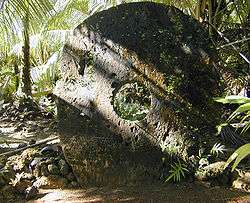His Majesty O'Keefe
| His Majesty O'Keefe | |
|---|---|
 | |
| Directed by | Byron Haskin |
| Produced by | Harold Hecht |
| Screenplay by |
Borden Chase James Hill |
| Based on |
novel by Lawrence Klingman Gerald Green |
| Starring |
Burt Lancaster Joan Rice André Morell Abraham Sofaer |
| Music by |
Dimitri Tiomkin (original score) Robert Farnon (alternate score: UK release) |
| Cinematography | Otto Heller |
| Edited by | Manuel del Campo |
Production company | |
| Distributed by | Warner Bros. |
Release date |
|
Running time | 91 minutes |
| Country | United States |
| Language | English |
| Budget | $1.5 million[1] |
| Box office | $2.5 million (US & Canada rentals)[2] |
His Majesty O'Keefe is a 1954 adventure film directed by Byron Haskin and starring Burt Lancaster. The cast also included Joan Rice, André Morell, Abraham Sofaer, Archie Savage, and Benson Fong. The screenplay by Borden Chase and James Hill was based on the novel of the same name by Laurence Klingman and Gerald Green (1952).[3]
Plot summary
Captain David O'Keefe (Burt Lancaster), seeking his fortune in the 19th century South Pacific, decides to enlist island natives to harvest copra, but runs into a wall of cultural problems. Backed by a Chinese dentist, he obtains a ship and sets about harvesting copra while fending off cantankerous native chieftains and ambitious German empire-builders. The natives, happy with their existence, see no reason to work hard to obtain copra, either for a German trading company or for O'Keefe. He finally motivates them by showing them how to produce large quantities of Rai stones, the stone money of Yap, their valued coinage.
Cast
- Burt Lancaster as Captain David O'Keefe / Narrator
- Joan Rice as Dalabo aki Dali
- André Morell as Alfred Tetens
- Abraham Sofaer as Fatumak, Medicine Man
- Charles Horvath as Bully Hayes
- Lloyd Berrell
- Grant Taylor
- Guy Doleman
- Tessa Prendergast as Kakofel
- Harvey Adams
- Muriel Steinbeck
- Philip Ahn as Sien Tang, Dentist and O'Keefe's partner
Historical basis

The story is based on the life of a sailor named David O'Keefe[3] who in 1871 was shipwrecked on Yap in the Caroline Islands, where he found the natives highly prized Rai stones quarried at great effort and danger on the island of Palau. He organized the natives to produce the large stone disks by employing modern methods and then used them to buy copra for coconut oil. The stones he produced were not valued as highly as those obtained by traditional methods due to the lack of personal sacrifice in their production, and the effect of an inflationary over-production.
Original book
O'Keefe's life was turned into a 1950 book. Film rights were bought by Norma Productions, the company of Harold Hecht and Burt Lancaster.[4] It was the last film in a six-picture deal between Hecht, Lancaster and Warner Bros. The others had been Kiss the Blood Off My Hands, The First Time, Ten Tall Men, The Flame and the Arrow, and The Crimson Pirate.
Production
The film was partly shot on location in the South Pacific in Fiji - not Yap. Also, indigenous people and customs/dances portrayed in the movie were Fijian. The choreographer was Daniel Nagrin. Some pre-production was done out of Sydney, Australia and a number of Australian actors had roles in the supporting cast. Director Byron Haskin later returned to Australia to make Long John Silver (1954).
Reception
The film was popular. However Warner Bros were unhappy by the fact it went over budget. Hecht and Lancaster brought in screenwriter James Hill to form Hecht-Hill-Lancaster and they signed with United Artists.
References
- ↑ Kate Buford, Burt Lancaster: An American Life, Da Capo 2000 p 124
- ↑ 'The Top Box-Office Hits of 1954', Variety Weekly, January 5, 1955
- 1 2 Klingman, Lawrence; Green, Gerald (1950). His Majesty O'Keefe. NY: Charles Scribner's Sons.
- ↑ LANCASTER TO STAR IN SHIPWRECK TALE: Norma Productions Buys 'His Majesty O'Keefe' for the Actor's First '52 Role By THOMAS F. BRADY Special to THE NEW YORK TIMES.. New York Times (1923-Current file); New York, N.Y. [New York, N.Y] 01 Jan 1951: 14.
- Chujoy, Anatole. The Dance Encyclopedia. (Simon and Schuster, 1967)
External links
- His Majesty O'Keefe on IMDb
- His Majesty O'Keefe at TCMDB
- Review of film at New York Times
- Review of film at Variety